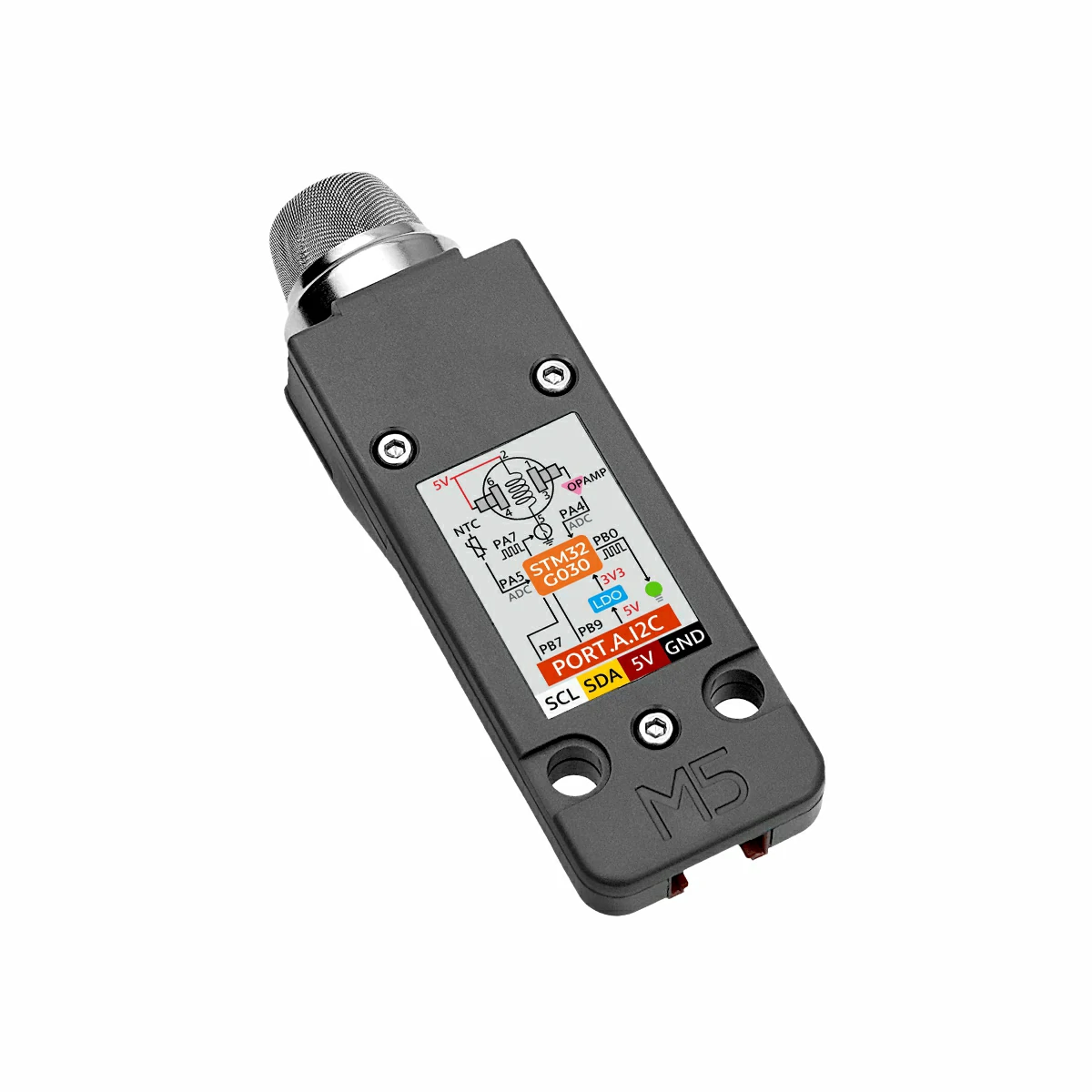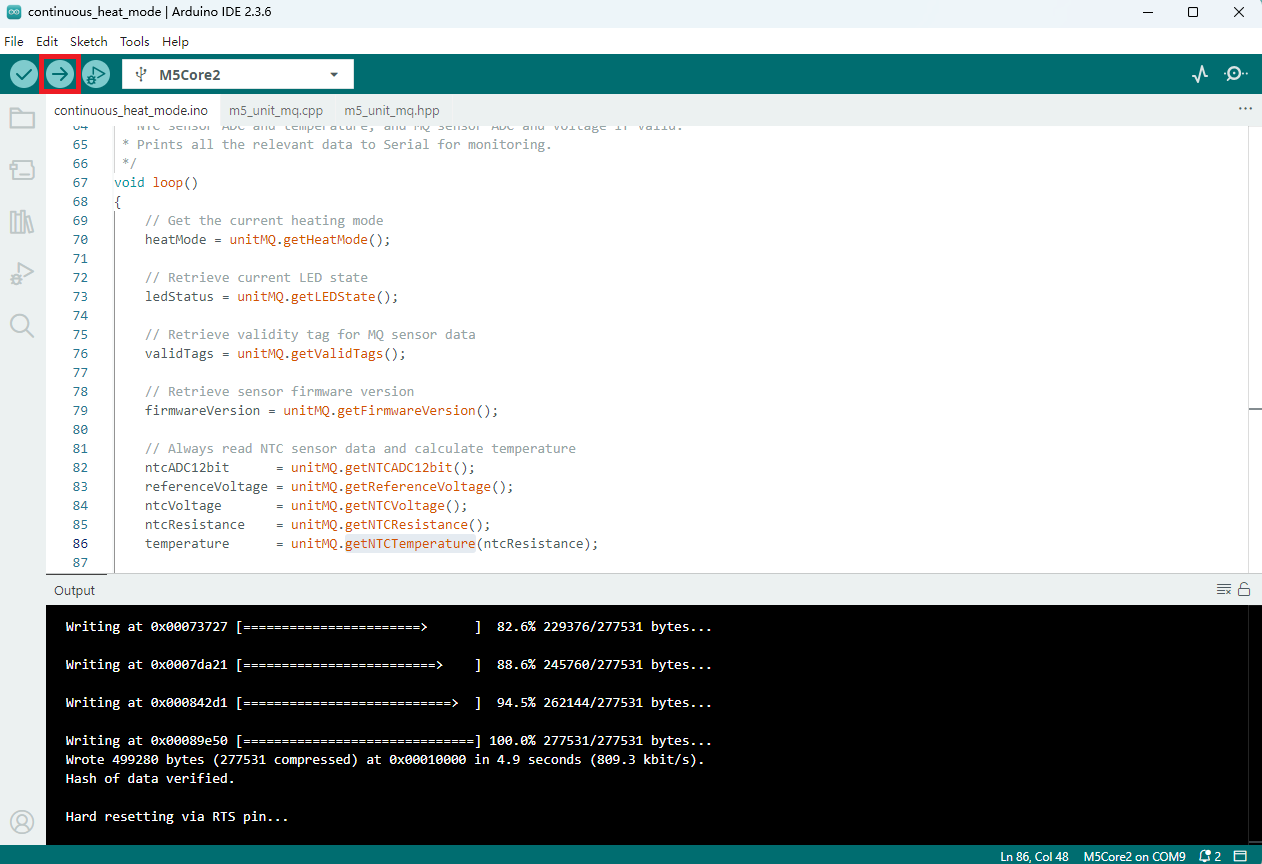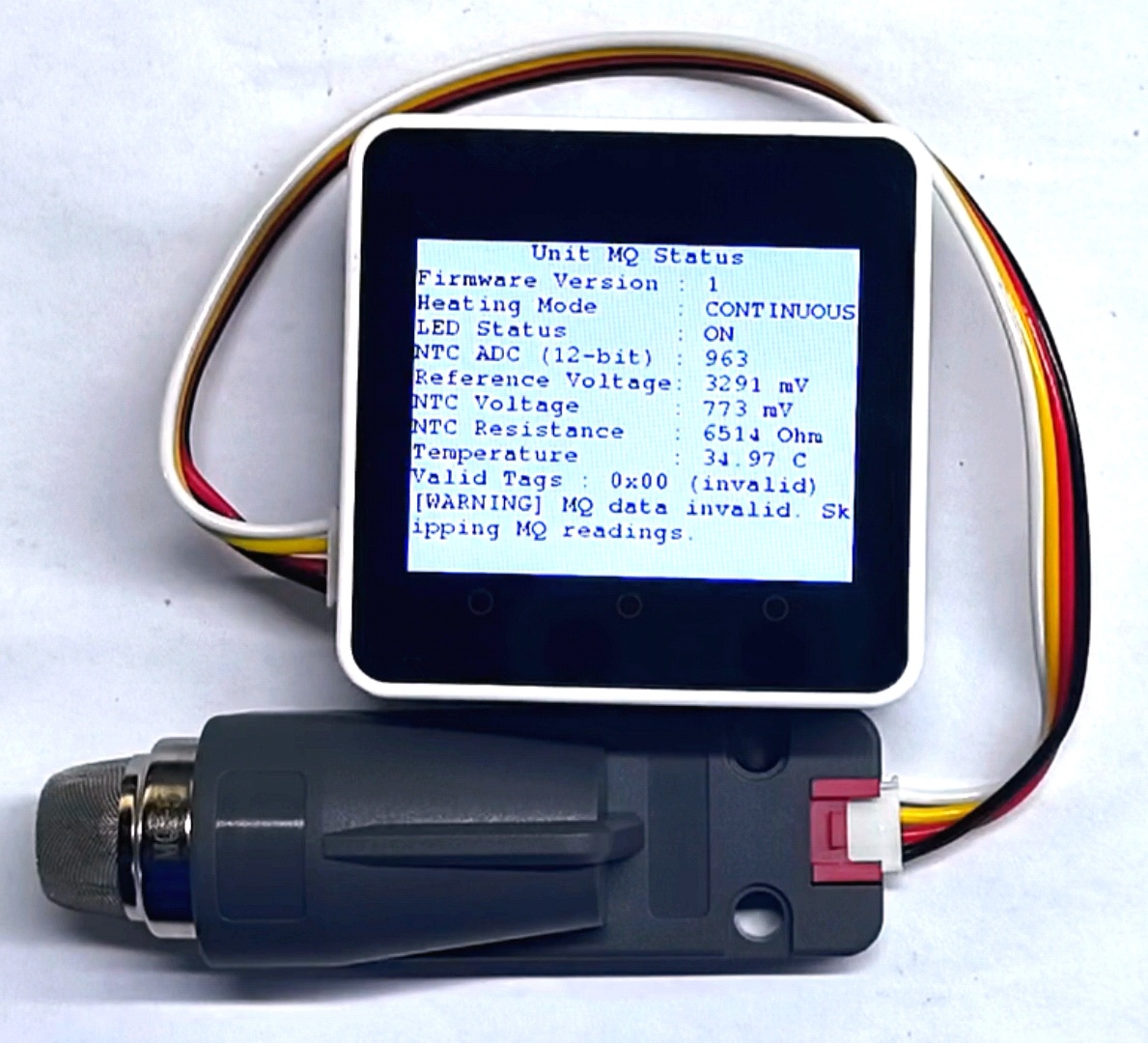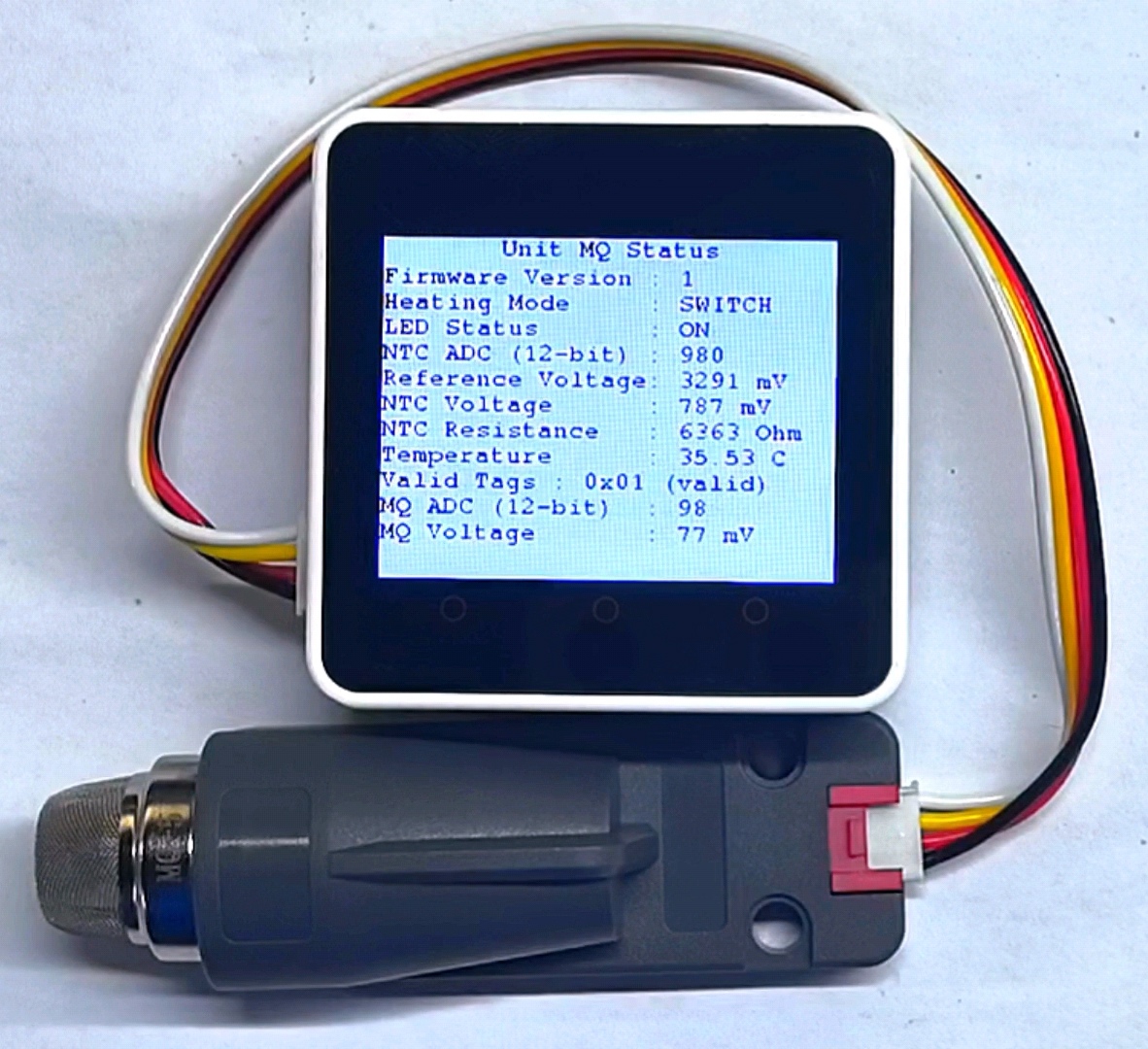Unit MQ Arduino 使用チュートリアル
1. 準備作業
- 環境構築: Arduino IDE スタートガイド を参考に IDE をインストールし、使用する開発ボードに応じたボードマネージャおよび必要なドライバライブラリをインストールしてください。
- 使用するドライバライブラリ:
- 使用するハードウェア製品:


2. 注意事項
ピン互換性
各ホストのピン設定は異なるため、ユーザーがより便利に使用できるよう 、M5Stack 公式はピン互換性表を提供しています。実際のピン接続状況に応じてサンプルコードを修正してください。
3. サンプルコード
このチュートリアルでは、Core2 v1.1 を主な制御デバイスとし、Unit MQ を組み合わせて使用します。本電流電圧測定ユニットは I2C 方式で通信します。実際の回路接続に応じてコード内のピン定義を修正してください。デバイス接続後の対応 I2C ピンは G33 (SCL)、G32 (SDA) です。
説明
1.高レベルを20秒間維持した後に、センサーデータが有効になります。低レベルに切り替えると、データ有効フラグは即座に0になります。データ有効フラグと加熱制御ピンの High/Low レベルの関係については図解を参照してください。
2.検出された可燃性ガスの
2.検出された可燃性ガスの
濃度が高いほど、Unit MQ が出力する電圧は高くなります。電圧と濃度 ppm に関する情報は、MQ-5 データシートを参照してください。- Unit MQ は連続加熱モード(
HEAT_MODE_CONTINUOUS)と間欠加熱モード(HEAT_MODE_PIN_SWITCH)の 2 種類の加熱モードを設定できます。取得できるデータは、センサー電圧、ADC 基準電圧、デバイス温度などがあり、必要に応じて選択してください。 - データ取得 API は以下の通りです:
getValidTags() // データ有効タグ
getReferenceVoltage() // 基準電圧
getNTCADC12bit() // NTC ADC
getNTCVoltage() // NTC 電圧
getNTCResistance() // NTC 抵抗値
getNTCTemperature(uint16_t ntcResistance) // NTC 温度
getMQADC12bit() // センサー ADC
getMQVoltage() // センサー電圧 連続加熱モード
cpp
1 2 3 4 5 6 7 8 9 10 11 12 13 14 15 16 17 18 19 20 21 22 23 24 25 26 27 28 29 30 31 32 33 34 35 36 37 38 39 40 41 42 43 44 45 46 47 48 49 50 51 52 53 54 55 56 57 58 59 60 61 62 63 64 65 66 67 68 69 70 71 72 73 74 75 76 77 78 79 80 81 82 83 84 85 86 87 88 89 90 91 92 93 94 95 96 97 98 99 100 101 102 103 104 105 106 107 108 109 110 111 112 113 114 115 116 117 118 119 120 121 122 123 124 125 126 127 128 129 130 131 132 133 134
#include <M5Unified.h>
#include <M5GFX.h>
#include "m5_unit_mq.hpp"
#define I2C_SDA (32) /**< I2C SDA pin number */
#define I2C_SCL (33) /**< I2C SCL pin number */
#define I2C_SPEED (400000) /**< I2C bus speed in Hz */
M5UnitMQ unitMQ; /**< Instance of the Unit MQ gas sensor */
/* Sensor status and data variables */
static led_status_t ledStatus = LED_WORK_STATUS_OFF; /**< Current LED state */
static heat_mode_t heatMode = HEAT_MODE_CONTINUOUS; /**< Current heating mode */
static mq_adc_valid_tags_t validTags = VALID_TAG_INVALID; /**< MQ ADC data validity flag */
static uint8_t highLevelTime = 0; /**< High-level heating time (not used here) */
static uint8_t lowLevelTime = 0; /**< Low-level heating time (not used here) */
static uint16_t mqADC12bit = 0; /**< MQ sensor raw ADC value (12-bit) */
static uint16_t ntcADC12bit = 0; /**< NTC sensor raw ADC value (12-bit) */
static uint16_t ntcResistance = 0; /**< Calculated NTC resistance in Ohms */
static uint16_t referenceVoltage = 0; /**< Reference voltage in millivolts */
static uint16_t mqVoltage = 0; /**< Calculated MQ sensor voltage in millivolts */
static uint16_t ntcVoltage = 0; /**< Calculated NTC sensor voltage in millivolts */
float temperature = 0.0f; /**< Calculated temperature in degrees Celsius */
static uint8_t firmwareVersion = 0; /**< Sensor firmware version */
/**
* @brief Arduino setup function, runs once at startup.
*
* Initializes the M5 hardware and Unit MQ sensor with I2C configuration.
* Retries sensor initialization until successful.
* Sets sensor heating mode and turns on the sensor LED.
*/
void setup()
{
M5.begin();
M5.Display.setRotation(1);
M5.Display.clear(TFT_WHITE);
M5.Display.setFont(&fonts::FreeMonoBold9pt7b);
M5.Display.setTextColor(TFT_BLACK);
Serial.begin(115200);
Serial.println("========== Unit MQ Initialization ==========");
// Initialize Unit MQ sensor on I2C bus, retry until success
while (!unitMQ.begin(&Wire, UNIT_MQ_I2C_BASE_ADDR, I2C_SDA, I2C_SCL, I2C_SPEED)) {
Serial.println("[ERROR] Unit MQ initialization failed! Retrying...");
delay(1000);
}
Serial.println("[INFO] Unit MQ initialization succeeded.");
// Set the heating mode to continuous heating
unitMQ.setHeatMode(HEAT_MODE_CONTINUOUS);
Serial.println("[INFO] Heating mode set to CONTINUOUS.");
// Turn on the sensor's LED indicator
unitMQ.setLEDState(LED_WORK_STATUS_ON);
Serial.println("[INFO] LED status set to ON.");
}
/**
* @brief Arduino main loop function, runs repeatedly.
*
* Reads sensor data including LED status, valid tags, firmware version,
* NTC sensor ADC and temperature, and MQ sensor ADC and voltage if valid.
* Prints all the relevant data to Serial for monitoring.
*/
void loop()
{
// Get the current heating mode
heatMode = unitMQ.getHeatMode();
// Retrieve current LED state
ledStatus = unitMQ.getLEDState();
// Retrieve validity tag for MQ sensor data
validTags = unitMQ.getValidTags();
// Retrieve sensor firmware version
firmwareVersion = unitMQ.getFirmwareVersion();
// Always read NTC sensor data and calculate temperature
ntcADC12bit = unitMQ.getNTCADC12bit();
referenceVoltage = unitMQ.getReferenceVoltage();
ntcVoltage = unitMQ.getNTCVoltage();
ntcResistance = unitMQ.getNTCResistance();
temperature = unitMQ.getNTCTemperature(ntcResistance);
// Print sensor status and readings
Serial.println("======== Unit MQ Status ========");
Serial.printf("Firmware Version : %d\n", firmwareVersion);
Serial.printf("Heating Mode : %s\n", heatMode == HEAT_MODE_CONTINUOUS ? "CONTINUOUS" : "SWITCH");
Serial.printf("LED Status : %s\n", ledStatus == LED_WORK_STATUS_ON ? "ON" : "OFF");
Serial.printf("NTC ADC (12-bit) : %u\n", ntcADC12bit);
Serial.printf("Reference Voltage : %u mV\n", referenceVoltage);
Serial.printf("NTC Voltage : %u mV\n", ntcVoltage);
Serial.printf("NTC Resistance : %u Ohm\n", ntcResistance);
Serial.printf("Temperature : %.2f °C\n", temperature);
M5.Display.clear(TFT_WHITE);
M5.Display.drawCenterString("Unit MQ Status", M5.Display.width()/2, 0);
M5.Display.setCursor(0, 20);
M5.Display.printf("Firmware Version : %d\n", firmwareVersion);
M5.Display.printf("Heating Mode : %s\n", heatMode == HEAT_MODE_CONTINUOUS ? "CONTINUOUS" : "SWITCH");
M5.Display.printf("LED Status : %s\n", ledStatus == LED_WORK_STATUS_ON ? "ON" : "OFF");
M5.Display.printf("NTC ADC (12-bit) : %u\n", ntcADC12bit);
M5.Display.printf("Reference Voltage: %u mV\n", referenceVoltage);
M5.Display.printf("NTC Voltage : %u mV\n", ntcVoltage);
M5.Display.printf("NTC Resistance : %u Ohm\n", ntcResistance);
M5.Display.printf("Temperature : %.2f C\n", temperature);
// Print MQ sensor readings only if data is valid
if (validTags == VALID_TAG_VALID) {
mqADC12bit = unitMQ.getMQADC12bit();
mqVoltage = unitMQ.getMQVoltage();
Serial.printf("Valid Tags : 0x%02X (MQ data valid)\n", validTags);
Serial.printf("MQ ADC (12-bit) : %u\n", mqADC12bit);
Serial.printf("MQ Voltage : %u mV\n", mqVoltage);
M5.Display.printf("Valid Tags : 0x%02X (valid)\n", validTags);
M5.Display.printf("MQ ADC (12-bit) : %u\n", mqADC12bit);
M5.Display.printf("MQ Voltage : %u mV\n", mqVoltage);
} else {
Serial.printf("Valid Tags : 0x%02X (MQ data invalid)\n", validTags);
Serial.println("[WARNING] MQ data invalid. Skipping MQ readings.");
M5.Display.printf("Valid Tags : 0x%02X (invalid)\n", validTags);
M5.Display.println("[WARNING] MQ data invalid. Skipping MQ readings.");
}
Serial.println("================================\n");
delay(1000); // Delay 1 second before next reading
}間欠加熱モード
cpp
1 2 3 4 5 6 7 8 9 10 11 12 13 14 15 16 17 18 19 20 21 22 23 24 25 26 27 28 29 30 31 32 33 34 35 36 37 38 39 40 41 42 43 44 45 46 47 48 49 50 51 52 53 54 55 56 57 58 59 60 61 62 63 64 65 66 67 68 69 70 71 72 73 74 75 76 77 78 79 80 81 82 83 84 85 86 87 88 89 90 91 92 93 94 95 96 97 98 99 100 101 102 103 104 105 106 107 108 109 110 111 112 113 114 115 116 117 118 119 120 121 122 123 124 125 126 127 128 129 130
#include <M5Unified.h>
#include <M5GFX.H>
#include "m5_unit_mq.hpp"
#define I2C_SDA (32) /**< I2C SDA pin number */
#define I2C_SCL (33) /**< I2C SCL pin number */
#define I2C_SPEED (400000) /**< I2C bus speed in Hz */
#define HIGH_LEVEL_TIME (30) /**< High level duration for pin switch mode in seconds */
#define LOW_LEVEL_TIME (10) /**< Low level duration for pin switch mode in seconds */
M5UnitMQ unitMQ; /**< Instance of the Unit MQ gas sensor class */
/* Sensor and system state variables */
static led_status_t ledStatus = LED_WORK_STATUS_OFF; /**< Current LED status */
static heat_mode_t heatMode = HEAT_MODE_PIN_SWITCH; /**< Heating mode of the sensor */
static mq_adc_valid_tags_t validTags = VALID_TAG_INVALID; /**< Validity tag for MQ sensor ADC data */
static uint8_t highLevelTime = 0; /**< High-level time setting for pin switch heating */
static uint8_t lowLevelTime = 0; /**< Low-level time setting for pin switch heating */
static uint16_t mqAdc12bit = 0; /**< Raw 12-bit ADC reading from MQ sensor */
static uint16_t ntcAdc12bit = 0; /**< Raw 12-bit ADC reading from NTC temperature sensor */
static uint16_t ntcResistance = 0; /**< Calculated resistance of NTC sensor (Ohms) */
static uint16_t referenceVoltage = 0; /**< Reference voltage value (mV) */
static uint16_t mqVoltage = 0; /**< Calculated voltage of MQ sensor output (mV) */
static uint16_t ntcVoltage = 0; /**< Calculated voltage of NTC sensor output (mV) */
float temperature = 0.0f; /**< Calculated temperature in Celsius */
static uint8_t firmwareVersion = 0; /**< Firmware version of the Unit MQ sensor */
void setup()
{
M5.begin();
M5.Display.setRotation(1);
M5.Display.clear(TFT_WHITE);
M5.Display.setFont(&fonts::FreeMonoBold9pt7b);
M5.Display.setTextColor(TFT_BLACK);
Serial.begin(115200);
Serial.println("========== Unit MQ Initialization ==========");
// Initialize the Unit MQ sensor with I2C settings.
// Retry initialization until successful.
while (!unitMQ.begin(&Wire, UNIT_MQ_I2C_BASE_ADDR, I2C_SDA, I2C_SCL, I2C_SPEED)) {
Serial.println("[ERROR] Unit MQ initialization failed! Retrying...");
delay(1000);
}
Serial.println("[INFO] Unit MQ initialization succeeded.");
// Set heating mode to PIN SWITCH mode, which alternates heating between HIGH and LOW levels.
unitMQ.setHeatMode(HEAT_MODE_PIN_SWITCH);
Serial.println("[INFO] Heating mode set to PIN SWITCH mode.");
// Configure the durations for high and low heating levels in PIN SWITCH mode.
unitMQ.setPulseTime(HIGH_LEVEL_TIME, LOW_LEVEL_TIME);
Serial.println("[INFO] Pin level switch time set to 30s HIGH and 5s LOW.");
// Turn on the sensor LED indicator.
unitMQ.setLEDState(LED_WORK_STATUS_ON);
Serial.println("[INFO] LED status set to ON.");
}
void loop()
{
// Get the current heating mode
heatMode = unitMQ.getHeatMode();
// Read the current LED status from the sensor.
ledStatus = unitMQ.getLEDState();
// Retrieve validity tag indicating whether MQ sensor data is reliable.
validTags = unitMQ.getValidTags();
// Get the firmware version from the sensor.
firmwareVersion = unitMQ.getFirmwareVersion();
// Always read NTC-related sensor data regardless of MQ data validity.
ntcAdc12bit = unitMQ.getNTCADC12bit(); // Raw ADC for NTC sensor
referenceVoltage = unitMQ.getReferenceVoltage(); // Reference voltage for ADC
ntcVoltage = unitMQ.getNTCVoltage(); // Calculated voltage across NTC
ntcResistance = unitMQ.getNTCResistance(); // Calculated resistance of NTC thermistor
temperature = unitMQ.getNTCTemperature(ntcResistance); // Convert resistance to temperature
Serial.println("======== Unit MQ Status ========");
Serial.printf("Firmware Version : %d\n", firmwareVersion);
Serial.printf("Heating Mode : %s\n", heatMode == HEAT_MODE_CONTINUOUS ? "CONTINUOUS" : "SWITCH");
Serial.printf("LED Status : %s\n", ledStatus == LED_WORK_STATUS_ON ? "ON" : "OFF");
// Print detailed NTC sensor parameters
Serial.printf("NTC ADC (12-bit) : %u\n", ntcAdc12bit);
Serial.printf("Reference Voltage : %u mV\n", referenceVoltage);
Serial.printf("NTC Voltage : %u mV\n", ntcVoltage);
Serial.printf("NTC Resistance : %u Ohm\n", ntcResistance);
Serial.printf("Temperature : %.2f °C\n", temperature);
M5.Display.clear(TFT_WHITE);
M5.Display.drawCenterString("Unit MQ Status", M5.Display.width()/2, 0);
M5.Display.setCursor(0, 20);
M5.Display.printf("Firmware Version : %d\n", firmwareVersion);
M5.Display.printf("Heating Mode : %s\n", heatMode == HEAT_MODE_CONTINUOUS ? "CONTINUOUS" : "SWITCH");
M5.Display.printf("LED Status : %s\n", ledStatus == LED_WORK_STATUS_ON ? "ON" : "OFF");
M5.Display.printf("NTC ADC (12-bit) : %u\n", ntcAdc12bit);
M5.Display.printf("Reference Voltage: %u mV\n", referenceVoltage);
M5.Display.printf("NTC Voltage : %u mV\n", ntcVoltage);
M5.Display.printf("NTC Resistance : %u Ohm\n", ntcResistance);
M5.Display.printf("Temperature : %.2f C\n", temperature);
// If MQ sensor data is valid, read and print MQ ADC and voltage values.
if (validTags == VALID_TAG_VALID) {
mqAdc12bit = unitMQ.getMQADC12bit();
mqVoltage = unitMQ.getMQVoltage();
Serial.printf("Valid Tags : 0x%02X (MQ data valid)\n", validTags);
Serial.printf("MQ ADC (12-bit) : %u\n", mqAdc12bit);
Serial.printf("MQ Voltage : %u mV\n", mqVoltage);
M5.Display.printf("Valid Tags : 0x%02X (valid)\n", validTags);
M5.Display.printf("MQ ADC (12-bit) : %u\n", mqAdc12bit);
M5.Display.printf("MQ Voltage : %u mV\n", mqVoltage);
} else {
// If MQ data is invalid, log a warning and skip readings.
Serial.printf("Valid Tags : 0x%02X (MQ data invalid)\n", validTags);
Serial.println("[WARNING] MQ data invalid. Skipping MQ readings.");
M5.Display.printf("Valid Tags : 0x%02X (invalid)\n", validTags);
M5.Display.println("[WARNING] MQ data invalid.\nSkipping MQ readings.");
}
Serial.println("================================\n");
delay(1000); // Wait for 1 second before next update
}4. コンパイルと書き込み
- デバイスポートを選択(詳細については プログラムのコンパイルと書き込み を参照)、Arduino IDE 左上のコンパイル & アップロードボタンをクリックし、コンパイルと書き込みが完了するのを待ちます。

5. 測定結果
Unit MQ の 2 つのモードの動作は下記の通りです:
連続加熱モード

間欠加熱モード

